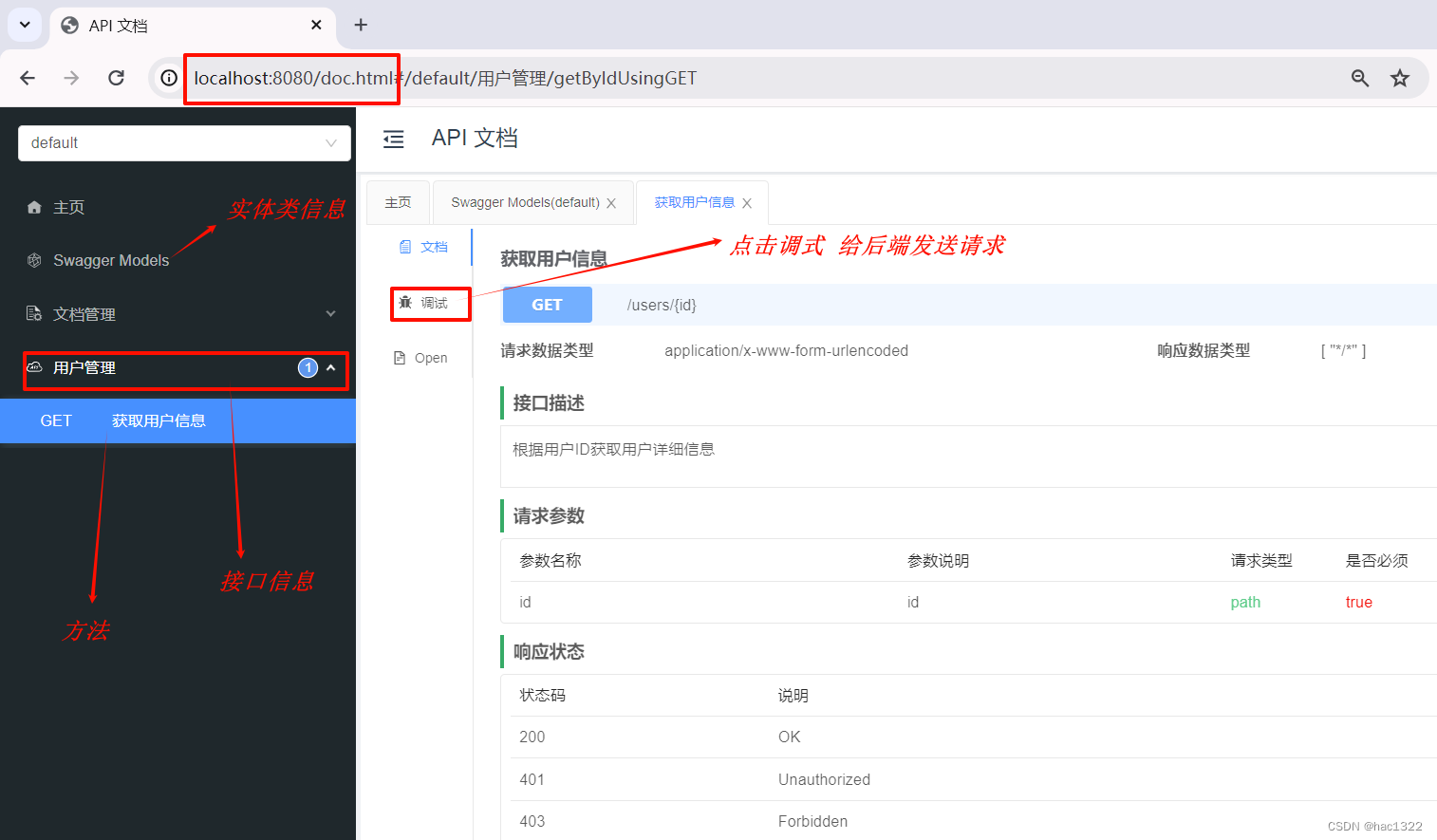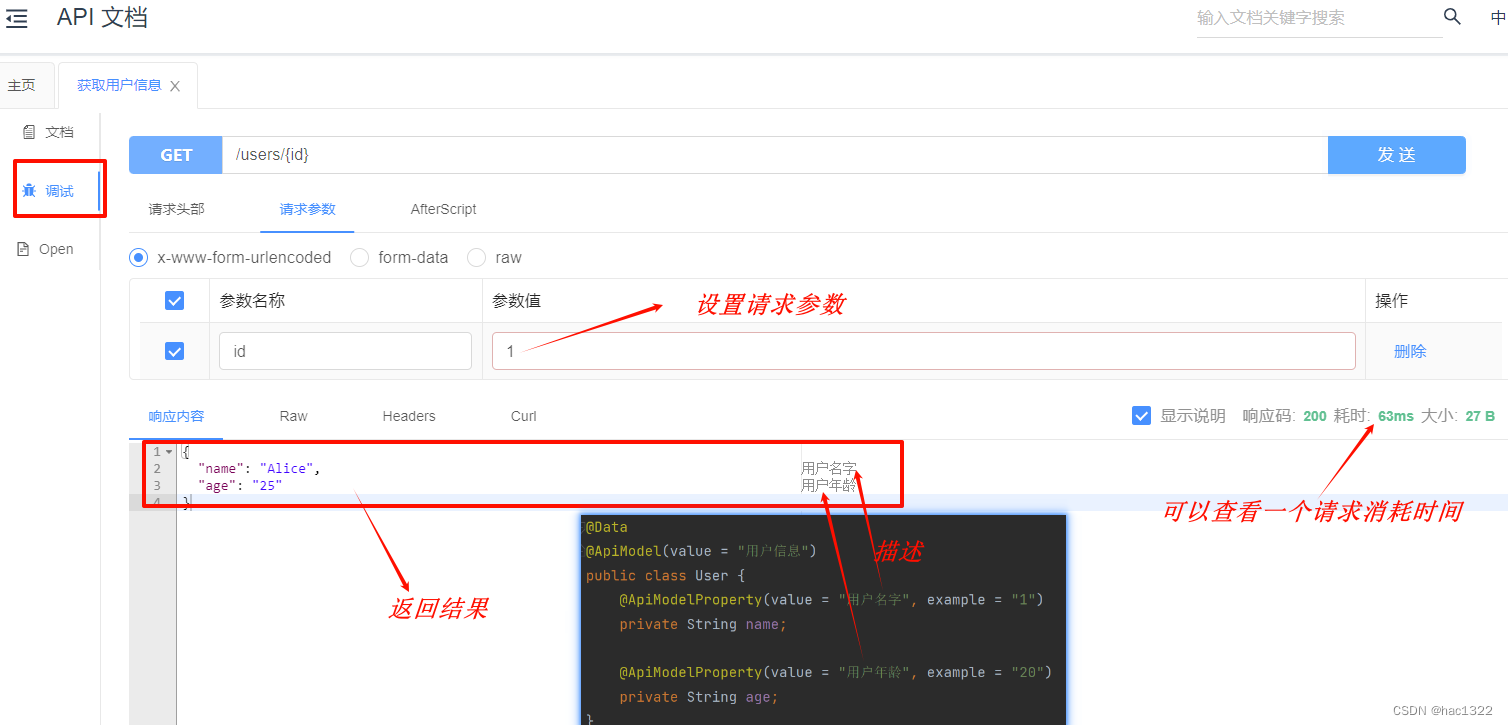文章目录
Knife4j 简介
Knife4j 是一个增强的 Swagger 文档生成工具,提供了更加友好的界面和更多功能,使得 API 文档更加美观且易于使用。它是基于 Spring Boot 和 Swagger 进行封装的,因此非常适合 Spring Boot 项目。
使用步骤
第一步:添加依赖
xml
<dependency>
<groupId>com.github.xiaoymin</groupId>
<artifactId>knife4j-spring-boot-starter</artifactId>
<version>3.0.3</version>
</dependency>第二步:配置 Swagger 配置类
java
import org.springframework.context.annotation.Bean;
import org.springframework.context.annotation.Configuration;
import springfox.documentation.builders.ApiInfoBuilder;
import springfox.documentation.builders.PathSelectors;
import springfox.documentation.builders.RequestHandlerSelectors;
import springfox.documentation.service.ApiInfo;
import springfox.documentation.spi.DocumentationType;
import springfox.documentation.spring.web.plugins.Docket;
@Configuration
public class SwaggerConfig {
@Bean
public Docket createRestApi() {
return new Docket(DocumentationType.OAS_30)
.apiInfo(apiInfo())
.select()
//TODO 改成自己的包名
.apis(RequestHandlerSelectors.basePackage("com.example.hac.controller"))
.paths(PathSelectors.any())
.build();
}
private ApiInfo apiInfo() {
return new ApiInfoBuilder()
.title("API 文档")
.description("API 接口文档的描述信息")
.version("1.0")
.build();
}
}第三步:配置 application.yml
yml
knife4j:
enable: true # 启用 Knife4j 功能
springdoc:
api-docs:
enabled: true # 启用 SpringDoc API 文档生成
swagger-ui:
enabled: true # 启用 Swagger UI 界面 Knife4j 常用注解的列表
| 注解 | 作用 | 示例 |
|---|---|---|
@Api |
标注在类上,用于描述该类的作用和功能,可以分组管理 API。 | @Api(tags = "用户管理") |
@ApiOperation |
标注在方法上,用于描述一个具体的操作(HTTP 请求),包括操作的功能、描述和其他细节。 | @ApiOperation(value = "获取用户信息", notes = "根据用户ID获取用户详细信息") |
@ApiModel |
标注在类上,用于描述一个 Model(实体类)的详细信息。 | @ApiModel(value = "用户信息") |
@ApiModelProperty |
标注在实体类的属性上,用于描述属性的详细信息,如字段说明、示例值等。 | @ApiModelProperty(value = "用户名字", example = "张三") |
@ApiParam |
标注在方法参数上,用于描述参数信息,如参数名称、类型、是否必填等。 | @ApiParam(name = "id", value = "用户ID", required = true) |
@ApiResponse |
标注在方法上,用于描述单个 HTTP 响应。 | @ApiResponse(code = 200, message = "请求成功") |
@ApiResponses |
标注在方法上,用于描述多个 HTTP 响应。 | @ApiResponses({@ApiResponse(code = 200, message = "请求成功"), @ApiResponse(code = 404, message = "未找到")}) |
@ApiImplicitParam |
标注在方法上,用于描述单个隐式参数。 | @ApiImplicitParam(name = "id", value = "用户ID", required = true, dataType = "int", paramType = "query") |
@ApiImplicitParams |
标注在方法上,用于描述多个隐式参数。 | @ApiImplicitParams({@ApiImplicitParam(name = "id", value = "用户ID", required = true, dataType = "int", paramType = "query")}) |
@ApiIgnore |
用于忽略某个类、方法或参数,使其不在 Swagger 文档中显示。 | @ApiIgnore |
案例
第一步:定义一个pojo
java
import io.swagger.annotations.ApiModel;
import io.swagger.annotations.ApiModelProperty;
import lombok.Data;
@Data
@ApiModel(value = "用户信息")
public class User {
@ApiModelProperty(value = "用户名字", example = "1")
private String name;
@ApiModelProperty(value = "用户年龄", example = "20")
private String age;
}第二步:编写controller service mapper
java
@RestController
@RequestMapping(value = "/users")
@Api(tags = "用户管理")
public class TestController {
@Autowired
private TestService testService;
@ApiOperation(value = "获取用户信息", notes = "根据用户ID获取用户详细信息")
@GetMapping(value = "/{id}")
public User getById(@PathVariable("id") int id) {
return testService.getById(id);
}
}第三步:启动项目 访问:http://localhost:8080/doc.html


注意
可能会遇到这个错误Failed to start bean 'documentationPluginsBootstrapper';

原因:这个错误是因为 Spring Boot 2.6.0 中引入了新的路径模式匹配策略,而 Swagger 3.0.0 使用了旧的路径匹配策略。这导致了 documentationPluginsBootstrapper 的启动失败
解决方法1:
在application.yml中添加下面这
yml
spring:
mvc:
pathmatch:
matching-strategy: ANT_PATH_MATCHER解决方法2:降低 Spring Boot 的版本
xml
<parent>
<groupId>org.springframework.boot</groupId>
<artifactId>spring-boot-starter-parent</artifactId>
<version>2.4.5</version>
</parent>❤觉得有用的可以留个关注❤